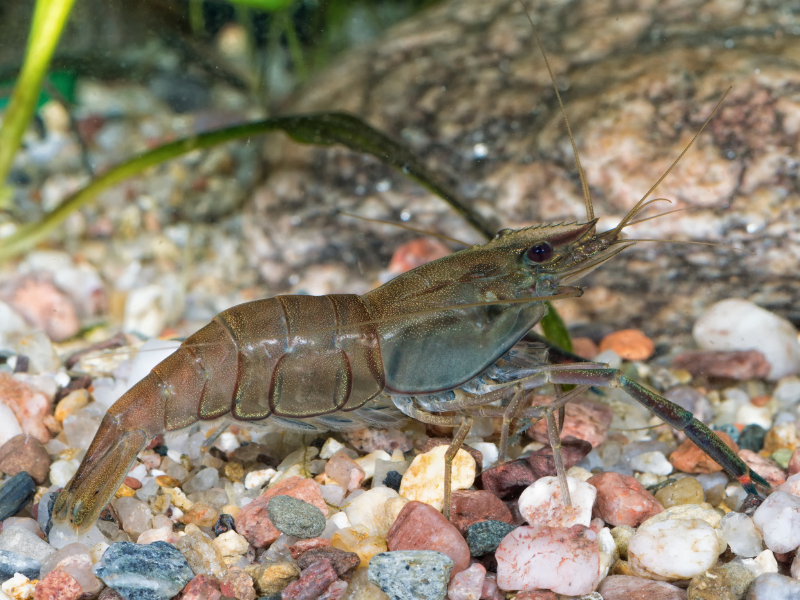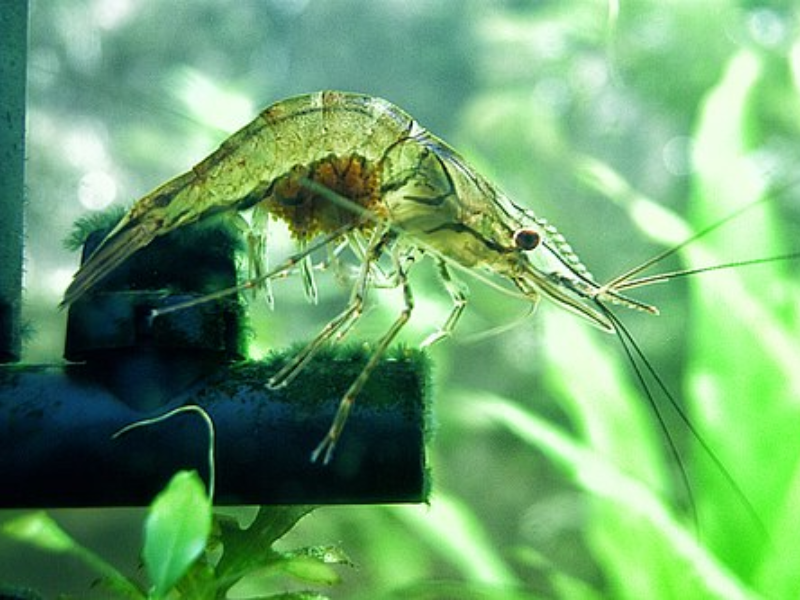Macrobrachium asperulum
Marbled river prawn

Scientific Classification
Quick Stats
Aquarium Building Information
About This Species
Basic Description
Detailed Description
The Marbled river prawn, also known as the Rough stone prawn, is a member of the extensive Macrobrachium genus, originating from the freshwater systems of Asia. In its natural habitat, it inhabits environments with a noticeable current, which should be replicated in an aquarium with good filtration that provides medium water flow. This species spends the vast majority of its time on the substrate, making it a classic bottom-dweller.
Setting up an appropriate habitat is key to its well-being. A spacious aquarium is necessary to accommodate its adult size and territorial behavior. The tank should be securely covered, as crustaceans are known for their attempts to escape. The aquascape should include numerous hiding places such as caves, driftwood, and rock formations. These structures are not just for aesthetics; they are crucial for providing security and defining territory, which can reduce stress. When it comes to plant life, this prawn has a tendency to uproot less-established or delicate plants during its foraging activities, so robust species like Anubias or Java Fern tied to decor are recommended.
This prawn is adaptable to a range of water conditions, tolerating a pH from slightly acidic to alkaline and water that is on the softer side to moderately hard. However, stability is more important than specific values. Maintaining warm, clean, and well-oxygenated water is essential for its health. Its moderate metabolism and waste production contribute a considerable bioload to the aquarium, necessitating an effective filtration system and a consistent schedule of water changes.
As an omnivore, its diet is straightforward. It is an opportunistic scavenger that will consume high-quality sinking pellets, algae wafers, frozen foods like bloodworms or brine shrimp, and blanched vegetables. This varied diet ensures it receives all necessary nutrients. Due to its solitary and territorial social profile, it is best kept alone. If housed with fish, tank mates should be fast-moving, mid-to-top dwelling species that are large enough not to be seen as prey. Any other bottom-dwellers, including other crustaceans, are likely to be met with aggression.
Scientific Description
Macrobrachium asperulum is a freshwater decapod crustacean belonging to the family Palaemonidae. As a member of the Macrobrachium genus, it is characterized by the enlarged second pair of chelipeds, a defining feature of these prawns. Its body morphology is compressiform, meaning it is flattened from side to side. Native to Asia, this species occupies a specific ecological niche in lotic ecosystems, preferring freshwater habitats with discernible water flow.
Its physiological adaptability allows it to thrive in a pH range spanning from acidic to moderately alkaline, and in water with low-to-medium mineral content. It is a strictly freshwater species, exhibiting very low tolerance for salinity. The species has a medium metabolic rate, oxygen consumption, and waste production, resulting in a moderate bioload factor. These characteristics are important considerations for maintaining water quality and dissolved oxygen levels in a closed system.
Ecologically, M. asperulum functions as an important detritivore and omnivore. Its diet consists of detritus, biofilm, algae, and small invertebrates, contributing significantly to nutrient cycling within its environment. Its foraging behavior, which includes disturbing the substrate and plant roots, is an integral part of its search for food. This prawn exhibits a solitary and territorial social structure, a behavior likely driven by competition for resources such as food and shelter. This territoriality is a key aspect of its behavioral ecology, influencing its spatial distribution in both natural and captive settings. According to the IUCN Red List, Macrobrachium asperulum is assessed as 'Least Concern' (LC), indicating that the species is currently not at risk and is relatively widespread throughout its native range.
Breeding Description
Breeding the Marbled river prawn is a moderately difficult endeavor that often requires specific conditions and a dedicated setup. The primary challenge lies in the complex larval development common to many species within the Macrobrachium genus.
Sexing these prawns can be accomplished by observing physical differences that become more apparent as they mature. Males typically develop significantly larger and more powerful chelae (claws) compared to females. Additionally, females often have a wider and deeper abdominal section (pleon), which is adapted to hold and protect her eggs, while the pleopods (swimmerets) under the abdomen may be broader and more feathery.
For a breeding attempt, a dedicated aquarium is highly recommended to protect the berried (egg-carrying) female from stress and other tank inhabitants. A pair can be conditioned on a high-protein diet in a spacious tank with pristine water conditions. After a successful mating, the female will carry the fertilized eggs under her abdomen, constantly fanning them with her swimmerets to keep them clean and oxygenated.
The reproductive method involves a larval stage. Upon hatching, the offspring are not miniature prawns but free-swimming, planktonic larvae. This is the most critical phase of the breeding process. In many Macrobrachium species, the larvae must be carefully transferred to a brackish water environment to undergo metamorphosis through several stages. Failure to provide this change in salinity will result in the death of the larvae. After they have successfully developed, they must be slowly and carefully reacclimated back to full freshwater. During their larval period, they require microscopic food sources like phytoplankton, rotifers, or newly hatched artemia. Once they have metamorphosed into post-larval shrimplets and are returned to freshwater, they can be weaned onto crushed flakes, pellets, and other small foods. Due to potential cannibalism, it is crucial to provide ample space and hiding spots as they grow.
Generate Printable Card
Create a printable card for this creature to display in your store or aquarium. The card includes a QR code for quick access to more information.
